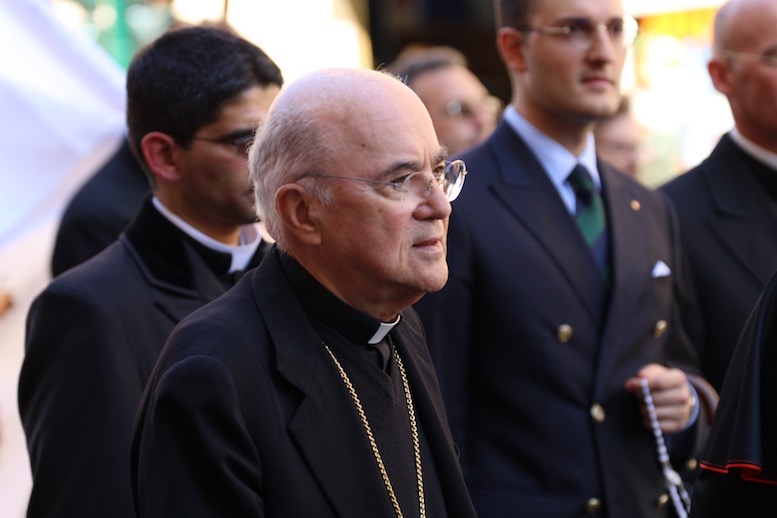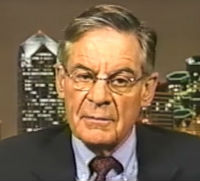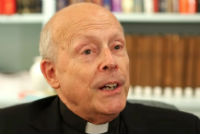2018: The Year of the Whistleblower
The Register looks back at those in the past year who helped bring the truth of the Church’s scandal to light

NEW YORK — On Oct. 19, the Feast of the North American Martyrs, Archbishop Carlo Maria Viganò issued his third “testimony” taking aim at an alleged Vatican cover up of sexual misconduct by Archbishop Theodore McCarrick.
The date of Archbishop Viganò’s latest letter underscored his assessment of the damage that clerical predators, aided by a powerful homosexual subculture, have wreaked on the lives of their victims and on the moral credibility of the Church.
In his closing remarks, the former nuncio to the United States appealed to those who could verify his claims, “or who have access to documents that can put the matter beyond doubt,” to come clean.
“You can … prop up the conspiracy of silence,” he said, or “you can choose to speak. You can trust Him who told us, ‘the truth will set you free.’”
Archbishop Viganò’s accusations against high-ranking Vatican officials are unprecedented in modern Church history. But even as he has earned a scathing rebuke from Cardinal Marc Ouellet, the prefect of the Congregation for the Bishops, his critique prompted the president of the U.S. Conference of Catholic Bishops to call for a full investigation into the former nuncio’s claims, and Catholics angered by the McCarrick scandal endorsed this plan.
In November, during a rally outside the Baltimore hotel where the U.S. bishops met to debate and vote on abuse reforms during their annual fall assembly, protestoes celebrated Archbishop Viganò’s decision to “speak,” repeatedly chanting his last name as a sign of their support for the prelate.
“Archbishop Viganò has played a very important role,” because he pointed to “the most probable explanation for the scandal: the presence of a homosexual network within the hierarchy, reaching up to the Vatican,” Philip Lawler, the author of two books about how clergy sexual abuse has injured the Church, told the Register.
But Archbishop Viganò is not the only Church whistleblower to draw headlines in a watershed year that featured incendiary allegations by victim-survivors and chancery staffers, seminary students, professors and psychologists that resulted in high-profile seminary investigations, and resignations by cardinals and bishops for alleged abuse or negligence.
Risk Assessment
Just days before the close of the year, the Vatican received the testimony of another man, James Grein, who claimed that Archbishop McCarrick began abusing him when he was just 11, in the late 1970s, and continued to do so for 18 years. Grein’s Dec. 27 deposition also alleged that Archbishop McCarrick assaulted him in the confessional. His searing account will be used in a Vatican trial or administrative penal process that could lead to McCarrick’s laicization.
The whistleblowers behind such shocking disclosures, said Lawler, “are guided by different motivations.” But those who have the most to lose — for example, a seasoned Vatican diplomat like Archbishop Viganò — also provide the most credible and compelling testimony.
The consistent theme in many of their stories is that they had pressed for action through approved channels before going public. Those who made such a fateful decision risked retribution, however, and would-be whistleblowers who have contacted the Register over the past year expressed fears that their ministry in the Church would be curtailed if they were known to be the source for new allegations.
“There is hardly any provision in the Church to protect them, even though they are acting on behalf of the Church as well as victims,” said Terry McKiernan, who leads the watchdog group, Bishop Accountability, which has posted an online list of whistleblowers, including diocesan and religious order priests, and women religious.
The U.S. bishops have announced plans for a new reporting mechanism that will allow whistleblowers to report sexual misconduct without fear of retaliation. But, in past years and still today, many have worried that such disclosures will make it “impossible to do the work they were born to do,” McKiernan told the Register.
South American Shakeup
In early 2018, one of the most prominent whistleblowers to shake up the Church was Juan Carlos Cruz, one of the Chilean victims of the notorious former Father Ferdinand Karadima. The priest was allegedly shielded by powerful Church leaders, including Bishop Juan Barros, whose appointment as ordinary of the Diocese of Osorno, Chile, sparked protests that overshadowed the Pope Francis’ January 2018 visit to the South American nation.
In short order, the Holy Father was obliged to launch an apostolic investigation that verified the victims’ claims, and then released a public apology to Cruz and other victim survivors. By June, all of Chile’s bishops had tendered their resignations en masse, with eight of them accepted to date.
Meanwhile, in Honduras, students at Tegucigalpa’s major seminary helped secure the resignation in July of Auxiliary Bishop Jose Juan Pineda Fasquelle, following accusations that he engaged in sexual misconduct with seminarians, and additional claims that a homosexual subculture had become entrenched in the seminary. Francis accepted Bishop Pineda’s resignation in July.

McCarrick: Turning Point?
By summer, however, the shocking news that Archbishop McCarrick had faced previous accusations of sexual misconduct with seminarians, but remained in public ministry and even rose through the Church hierarchy to become a cardinal, marked a new, and possibly decisive chapter in the U.S. clergy abuse crisis.
As many Catholics raised questions about the Vatican’s failure to act on reports of McCarrick’s misconduct, media outlets spotlighted the efforts of two unsung whistleblowers: Richard Sipe and Father Boniface Ramsey.
A former Benedictine who left the priesthood, Sipe was a leading advocate for victims, and a psychotherapist who specialized in priestly celibacy and sexual problems and once served in a number of seminaries. He died in August.
“In the ’80s, Richard had seminarians telling him that McCarrick always wanted one of them to sleep with him,” Marianne Benkert, Sipe’s widow and collaborator, told the Register, during a telephone interview from her home in La Jolla, California.
“He wrote to the Vatican about this, and never got any answers.” When Sipe “tried to get McCarrick’s victims to come forward publicly, they said they couldn’t,” she reported, noting their fears of reprisals.
Later, Sipe used his website to post information about McCarrick’s misconduct with seminarians and priests under his authority, including a graphic account culled from a financial settlement.
In 2016, two years before McCarrick was finally removed from public ministry, Sipe wrote a letter to Bishop Robert McElroy of San Diego that offered a prescient glimpse of the fresh scandals to come.
“When men in authority — cardinals, bishops, rectors, abbots, confessors, professors — are having or have had an unacknowledged-secret-active-sex-life under the guise of celibacy, an atmosphere of tolerance of behaviors within the system is made operative,” warned Sipe.

Seton Hall Witness
That specific problem was a source of deep concern for Father Bonifice Ramsey, a New York priest who previously served on the faculty of the Immaculate Conception seminary at Seton Hall University in New Jersey from 1986-1996.
During his years at Immaculate Conception, Father Ramsey said he witnessed a seminarian engage in behavior that “seemed to involve sexual abuse, homosexual abuse.”
In an interview with the Register earlier this year, he described his successful effort to expel the student, whose actions he judged to be “irredeemable.”
But after the student’s expulsion, “McCarrick fired me from the voting faculty, because the person I [helped to expel] was one of ‘his’ seminarians,” said Father Ramsey. “McCarrick didn’t like that.”
In 2000, Father Ramsey shared his concerns in a letter to the U.S. nuncio, Archbishop Gabriel Montalvo, but never received a formal reply. In 2015, he wrote Cardinal Sean O’Malley, the president of the Pontifical Commission for the Protection of Young People, and received a letter from the Boston archbishop’s secretary, who explained that he had no authority to address the priest’s concerns.
After Archbishop Viganò’s testimony confirmed that Vatican officials had received Father Ramsey’s 2000 letter, the priest said he has received a steady stream of phone calls from New Jersey clerics and others who have been overwhelmed by the ongoing revelations.
“Virtually every day someone calls me,” he told the Register in December. “They want to be reassured that there is somebody out there, especially a member of the clergy, who will blow the whistle.”
He said that people usually congratulate him “for my ‘courage,’ but it was anger and dismay that propelled me.”

Buffalo Revelations
In August, just weeks after Archbishop Viganò released his first bombshell testimony, another whistleblower surfaced in the Diocese of Buffalo, New York.
Siobhan O’Connor, a former executive assistant to Bishop Richard Malone of Buffalo told 60 Minutes that she provided diocesan personnel files to a local reporter because of the local Church’s alleged failure to provide a complete account of priests facing credible accusations of abuse involving minors, when it posted a list of 42 names in March.
The resulting news reports focused on two priests who remained in active ministry as late as March 2018. Both of them had been vetted for inclusion in the public list of accused priests, but were not added to that list in the end.
During an interview with the Register, O’Connor said that after the diocese launched an independent reconciliation program for victim survivors, there was an influx of calls, and she handled some of them.
“I discovered the scope and traumatic nature of the abuse.” she said.
Over time, she also came to believe that “the bishop was not taking proper action with regard to one priest’s case.”
O’Connor had repeatedly pressed him to begin a recommended review of the matter, but it was put off until the threat of investigation by law enforcement or the media moved things forward.
“As a lifelong faithful Catholic, I would never have thought about going to the media about my bishop or diocese, but I saw there was no internal impetus to change,” she said.
Bishop Malone has defended the diocese’s efforts to provide a complete list of accused priests.
O’Connor accepted a new job before the leaked documents she provided made headlines. A single woman with no children, she believes that she was in a better position to take action than most would-be whistleblowers.
“I was the right person at the right time,” she said, and credited Archbishop Viganò as a source of inspiration.
Agonizing Decisions
The former nuncio had described the decision to break his silence as the fruit of an agonizing examination of conscience, and a consuming fear that he would be harshly judged by God for failing to do his duty.
Archbishop Viganò “was speaking as someone in his later years,” said O’Connor. “But even at 35 I realized I couldn’t walk away. There is a great peace of soul that comes when you do this.”
The establishment of new independent mechanisms for reporting abuse will increase the likelihood that more people with critical information will come forward in the months ahead. Likewise, the ongoing investigation of Archbishop McCarrick’s record in the four dioceses where he previously served may bring other whistleblowers out of the shadows, even as it is expected to provide the names of high-ranking Church leaders who tolerated his misbehavior.
For now, 2018 is the Year of the Whistleblower. In hindsight, the full impact of this extraordinary moment will be understood more clearly. Will it be dismissed as a lost opportunity to end the "conspiracy of silence" shielding predatory clerics, or the start of a seismic shift in how the Church addresses the scandal across the globe?
Joan Frawley Desmond is a Register senior editor.
















